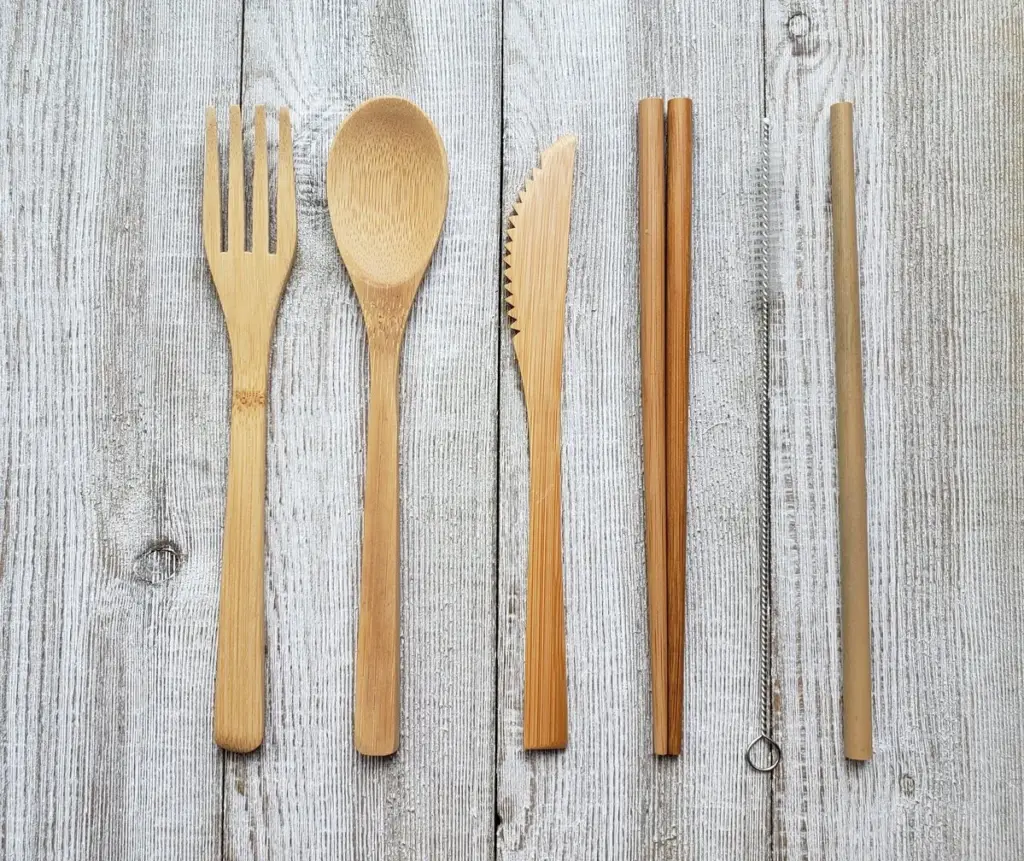Reviewed by Godfrey Ogbo
Yes, biodegradable silverware does exist. Let’s dive into the article so you can know more about the best sustainable silverware to purchase.
What Is Biodegradable Silverware?
It refers to eating utensils (such as forks, knives, and spoons) that are made from materials that can naturally break down and decompose over time, typically within a reasonable timeframe.
These materials are often derived from renewable resources like cornstarch, potato starch, or other plant-based sources.
It is considered an eco-friendly alternative to traditional plastic or metal utensils because it reduces the environmental impact and waste associated with single-use utensils.
What are Biodegradable Utensils Made of?

Biodegradable utensils are typically made from a variety of renewable and biodegradable materials. The best silverware options can vary depending on your specific needs and preferences.
However, here are some popular and widely regarded biodegradable cutlery materials that are considered eco-friendly:
1. Cornstarch-Based Cutlery
Utensils made from cornstarch are a standard and affordable option. They are sturdy enough for most single-use purposes and break down naturally.
2. Bamboo Cutlery
Bamboo utensils are not only biodegradable but also reusable. They are durable and have a natural appearance. They can be an excellent choice for those looking for a more sustainable option.
3. Wheat Straw Cutlery
Wheat straw is a byproduct of wheat production and is used to make biodegradable utensils. They are lightweight and suitable for single-use applications.
4. Palm Leaf Cutlery
Utensils made from palm leaves are natural and biodegradable. They have an attractive, rustic appearance and are often used for special occasions.
5. Sugarcane Bagasse Cutlery
Bagasse is a byproduct of sugarcane processing and is used to make biodegradable plates, bowls, and utensils. It is sturdy and compostable, and also a beautiful biodegradable cutlery.
6. Wooden Cutlery
Wooden utensils, such as those made from birch or beechwood, are biodegradable and can be an excellent choice for eco-conscious consumers. They are often used in cafes and restaurants.
7. PLA (Polylactic Acid) Cutlery
PLA is a bioplastic made from fermented plant starch (usually corn). PLA utensils are compostable under the right conditions, so they are a good option if you have access to a commercial composting facility.
These materials are chosen for their ability to break down naturally, reducing the environmental impact of single-use utensils compared to traditional plastics.
Keep in mind that the specific composition may vary between brands and products, so it’s a good practice to check product labels or descriptions for details on the materials used.
What’s the Difference Between Biodegradable and Compostable Silverware?
Biodegradable and compostable silverware are both environmentally friendly alternatives to traditional plastic utensils, but they have some differences in how they break down:
Biodegradable Silverware
This type of silverware will naturally break down over time into smaller components. However, the timeframe for this decomposition can vary, and some biodegradable materials may take years to degrade fully.
Biodegradable utensils can break down in various environments, not just composting facilities. They may degrade in landfills, soil, or natural settings, depending on the material used.
The term “biodegradable” doesn’t guarantee that the utensils will turn into nutrient-rich compost suitable for enriching soil.
Compostable Silverware

Compostable cutlery is specifically designed to break down into nutrient-rich compost when placed in a composting facility. These utensils typically decompose more quickly and under controlled conditions.
Compostable utensils contribute to the creation of compost, a valuable soil amendment, and don’t leave behind harmful residues.
To be labelled as “compostable,” cutlery must meet specific industry standards, which ensure that the utensils break down within a specific timeframe and result in high-quality compost.
While both biodegradable and compostable cutlery are better for the environment than traditional plastics, compostable utensils are designed to break down faster and produce nutrient-rich compost when processed in a composting facility.
Biodegradable silverware, on the other hand, may break down more slowly and in various environments, and the resulting breakdown products may not necessarily be suitable for enriching soil.
It’s important to follow local composting guidelines when disposing of compostable cutlery to ensure they are processed correctly.
Are Biodegradable Utensils Really Compostable?
Compostable silverware is designed to be compostable under the right conditions, typically in a commercial composting facility. However, there are some important considerations to keep in mind:
Composting Conditions
It requires specific conditions to break down properly. These conditions include the right temperature, humidity, and microbial activity, which are typically found in industrial composting facilities.
In-home composting or natural environments, compostable utensils may break down more slowly or not at all.
Certification
Look for utensils that are certified as compostable according to recognized standards, such as ASTM D6400 (in the United States) or EN 13432 (in Europe). Certification ensures that the utensils meet specific criteria for compostability.
Facility Availability
Check if there are commercial composting facilities in your area. Not all areas have access to these facilities, and if you don’t, the utensils may not be able to be composted properly.
Home Composting
Some compostable utensils may break down in a home compost pile, but this can vary depending on the material and conditions. It’s advisable to follow the manufacturer’s instructions and local composting guidelines.
Disposal
Proper disposal is crucial. If you have access to a commercial composting facility, make sure to dispose of compostable utensils there. Please don’t dispose of them in regular trash, as they won’t break down in a landfill.
Benefits of Biodegradable Utensils
Biodegradable utensils offers several benefits:
1. Reduced Environmental Impact
It is made from materials that naturally break down over time. This reduces the amount of plastic waste in landfills and oceans, helping to mitigate environmental pollution.
2. Renewable Resources
Many biodegradable utensils are made from renewable resources such as cornstarch, potato starch, or bamboo. This reduces dependence on finite fossil fuel resources used to make traditional plastic utensils.
3. Lower Carbon Footprint
The production of biodegradable utensils often has a lower carbon footprint compared to petroleum-based plastics, contributing to reduced greenhouse gas emissions.
4. Decreased Litter
Biodegradable utensils are less likely to persist in the environment as litter since it breaks down naturally. This can help keep public spaces cleaner and reduce the visual pollution of discarded plastic cutlery.
5. Composting Benefits
Some biodegradable utensils are compostable and can be turned into nutrient-rich compost when processed in composting facilities. This enriches the soil and reduces the need for chemical fertilizers.
6. Consumer Choice
It provides consumers with a more sustainable option for single-use utensils, allowing individuals to make environmentally conscious choices.
7. Regulatory Support
Many regions have implemented regulations and standards for biodegradable and compostable products, ensuring that they meet specific criteria for eco-friendliness.
8. Corporate Responsibility
Businesses and food service providers that use biodegradable utensils can demonstrate their commitment to environmental sustainability, which can be appealing to eco-conscious customers.
Conclusion
By harnessing renewable resources and offering a greener alternative to traditional utensils, biodegradable silverware presents a compelling solution to reduce plastic waste, lower carbon footprints, and promote environmental sustainability.
These eco-friendly options empower consumers and businesses alike to make more environmentally responsible choices in our quest to protect the planet.
Related posts:
- 389 Adjectives Starting with Z (Positive Words and Others) - January 12, 2024
- 389 Adjectives Starting with Y (Positive words and Others) - January 11, 2024
- 389 Adjectives Starting with X (Positive words and Others) - January 10, 2024






